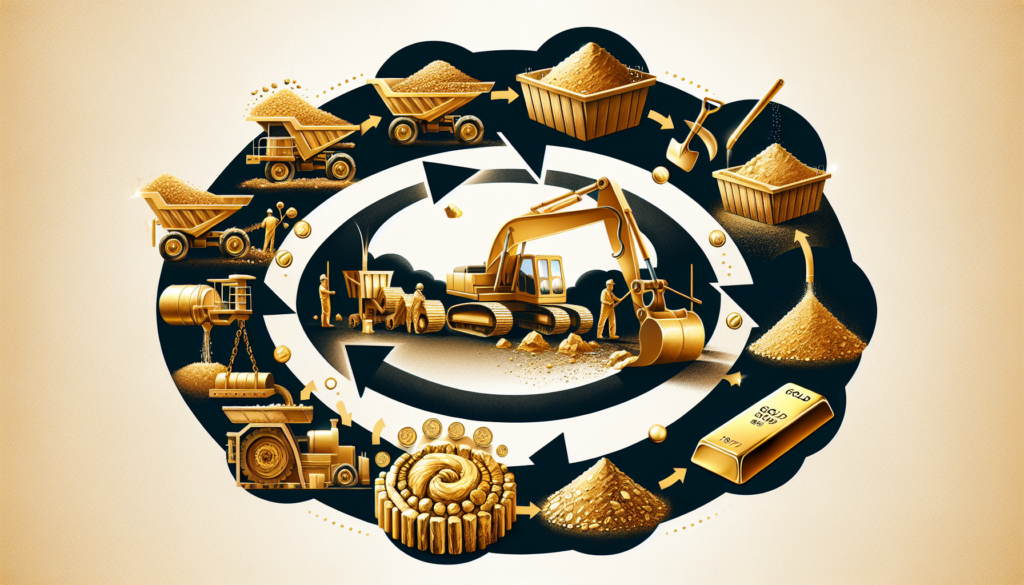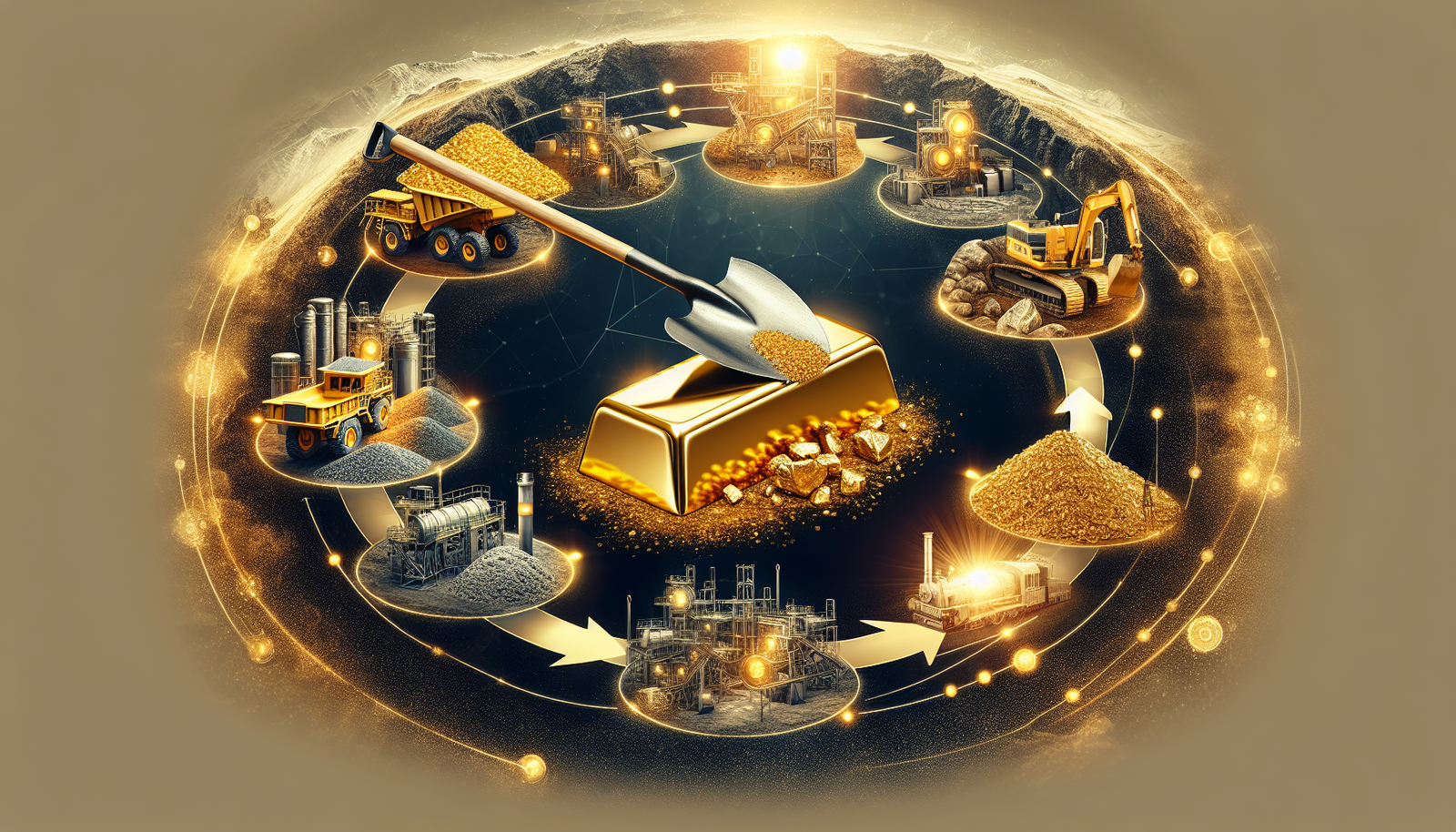Imagine embarking on a journey to discover the fascinating lifecycle of a gold mine. Glittering with possibilities, this article will take you on an exploration of the entire process, from initial exploration to reclamation. Join us as we delve into the intricate web of activities and innovations that make up the mesmerizing world of gold mining. Step into the shoes of a mining professional and unravel the secrets behind the shimmering allure of this precious metal. Get ready to be awestruck by the meticulous planning, cutting-edge technology, and environmental stewardship that shape the lifecycle of a gold mine.
Exploration Phase
During the exploration phase of a gold mine, the first step is to identify potential gold deposits. This involves studying geological maps and conducting surveys to locate areas with high mineral potential. Geological surveys are then carried out to gather detailed information about the geology, structure, and mineralization of the identified areas.
Once potential gold deposits have been identified, drilling and sampling are conducted to obtain core samples from the ground. These samples are analyzed to determine the gold content and quality. This helps in assessing the economic viability of the deposit and estimating the potential size and grade of the ore body.
Feasibility Study
After the exploration phase, a feasibility study is conducted to evaluate the practicality of developing a gold mine in the identified area. This study involves determining the optimal mine design, taking into account factors such as depth, size, and shape of the deposit, as well as surrounding geology and environmental considerations.
An environmental impact assessment is a crucial part of the feasibility study. It involves evaluating the potential environmental impacts of mining activities and developing strategies to minimize and mitigate those impacts. This ensures that the mine is operated in an environmentally responsible manner.
Estimating costs and conducting a financial analysis are also important components of the feasibility study. This includes assessing the capital and operating costs of the mine, as well as projecting the potential revenue and profitability. In addition, obtaining the necessary permits and licenses from regulatory authorities is crucial before proceeding with mine development.

Mine Development
Once the feasibility study has been completed and all necessary permits and licenses are obtained, the mine development phase begins. This phase involves clearing and preparing the site for mining activities. Vegetation and topsoil are removed, and infrastructure such as roads, power lines, and water supply systems are constructed.
Establishing access roads is crucial to ensure the efficient transportation of equipment, materials, and personnel to and from the mine site. These roads are designed to withstand heavy loads and challenging terrain. Similarly, installing utilities and facilities such as power generators, water treatment plants, and accommodation units are necessary to support the mine operations.
Extraction and Processing
The extraction and processing phase involves the actual extraction of gold from the ore. The method of extraction depends on various factors such as the depth and grade of the deposit. Two common methods of extraction are open-pit mining and underground mining.
In open-pit mining, the ore is removed by drilling and blasting, and then loaded onto trucks or conveyor belts for transportation to the processing plant. In underground mining, tunnels or shafts are excavated to access the ore body, and the ore is then transported to the surface.
Once the ore reaches the processing plant, it undergoes crushing and grinding to reduce its size. This is followed by chemical processing, where chemicals are used to extract gold from the ore. The ore is subjected to various processes such as leaching, carbon adsorption, and precipitation, which ultimately result in the extraction of gold.

Ore Transportation
After the extraction and processing phase, the next step is to transport the ore from the mine site to the processing plant. This is typically done using trucks, conveyors, or rail systems, depending on the distance and logistics. Proper handling and safety measures are essential to prevent spillage and ensure efficient transportation.
Trucks are commonly used for short-distance transportation, while conveyors are employed for longer distances. Rail systems are also utilized when mines are located far away from the processing plant. Regardless of the method used, transportation of the ore requires careful planning and coordination to maintain a steady supply to the processing plant.
Processing and Refining
Once the ore reaches the processing plant, further crushing and grinding take place to further reduce its size. The goal is to achieve the desired particle size for effective chemical processing. Chemical processes, such as pressure leaching or cyanidation, are then employed to remove impurities and extract gold from the ore.
In pressure leaching, the ore is subjected to high temperatures and pressures to dissolve gold-bearing minerals. Cyanidation involves the use of a weak cyanide solution to dissolve gold from the ore. These processes result in the production of a gold-rich solution, which is further processed to obtain pure gold.
To refine the gold to the desired purity, additional processes such as smelting or electrorefining may be employed. Smelting involves heating the gold-rich solution to a high temperature, causing the gold to separate and solidify. Electrorefining uses an electric current to remove impurities from the gold, resulting in a more refined product.
Waste Management
Waste management is a critical aspect of gold mining operations to minimize environmental impacts. Managing mine tailings and waste rock is an important part of this process. Tailings are the materials left over after the extraction of valuable minerals from the ore, while waste rock refers to the non-valuable rock that is removed during mining.
To prevent environmental contamination, proper storage and containment of mine tailings and waste rock are crucial. This typically involves constructing secure storage facilities such as tailings ponds and waste rock disposal areas. Monitoring and treatment of water discharges from these storage facilities are also necessary to ensure the protection of water resources.
Mine Closure and Reclamation
At some point, every gold mine reaches the end of its productive life. The mine closure and reclamation phase involves ceasing mining operations and restoring the site to its pre-mining condition. This includes rehabilitating the site by regrading, replanting vegetation, and restoring natural ecosystems.
Implementing a closure plan during the mine development phase is essential to ensure a smooth transition to the closure and reclamation phase. This plan outlines the steps and measures that will be taken to mitigate environmental impacts during and after mining operations. It also includes provisions for the post-closure monitoring and maintenance of the site.
Post-Closure Monitoring
Even after a gold mine has been closed and reclaimed, post-closure monitoring is necessary to ensure long-term environmental protection. This involves regular monitoring of air, water, and soil quality to assess any potential impacts from the closed mine. Any issues that arise during the monitoring process can be addressed promptly to protect the environment.
The purpose of post-closure monitoring is to ensure that the site remains stable and does not pose a risk to human health or the environment. It provides an opportunity to detect and address any potential environmental issues early on, thereby avoiding long-term consequences and safeguarding the surrounding ecosystems.
Legacy and Sustainable Development
Gold mining has a lasting legacy and impact on the environment, economy, and local communities. Assessing the social and economic impacts of mining operations is crucial in order to promote sustainable mining practices. This involves evaluating the benefits and challenges associated with mining activities and finding ways to maximize positive impacts while mitigating negative ones.
Promoting sustainable mining practices involves implementing environmentally responsible mining techniques, minimizing water and energy usage, and reducing emissions and waste generation. Engaging with local communities and stakeholders is essential to ensure transparent and inclusive decision-making processes. Responsible use of resources, such as water and energy, is also necessary to minimize the ecological footprint of gold mining operations.
In conclusion, understanding the lifecycle of a gold mine is crucial for responsible and sustainable mining practices. From the exploration phase to mine closure and reclamation, each stage involves careful planning, implementation, and monitoring to minimize environmental impacts and ensure long-term environmental protection. By adopting and promoting sustainable mining practices, the gold mining industry can help preserve natural resources and contribute positively to local communities and economies.

